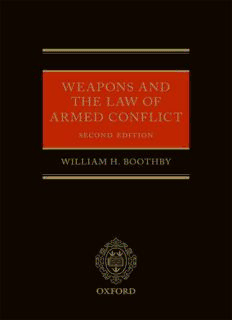
Weapons and the law of armed conflict PDF
Preview Weapons and the law of armed conflict
WEAPONS AND THE LAW OF ARMED CONFLICT Weapons and the Law of Armed Conflict Second Edition WILLIAM H. BOOTHBY 1 1 GreatClarendonStreet,Oxford,OX26DP, UnitedKingdom OxfordUniversityPressisadepartmentoftheUniversityofOxford. ItfurtherstheUniversity’sobjectiveofexcellenceinresearch,scholarship, andeducationbypublishingworldwide.Oxfordisaregisteredtrademarkof OxfordUniversityPressintheUKandincertainothercountries ©WilliamH.Boothby2016 Themoralrightsoftheauthorhavebeenasserted FirstEditionpublishedin2009 SecondEditionpublishedin2016 Impression:1 Allrightsreserved.Nopartofthispublicationmaybereproduced,storedin aretrievalsystem,ortransmitted,inanyformorbyanymeans,withoutthe priorpermissioninwritingofOxfordUniversityPress,orasexpresslypermitted bylaw,bylicenceorundertermsagreedwiththeappropriatereprographics rightsorganization.Enquiriesconcerningreproductionoutsidethescopeofthe aboveshouldbesenttotheRightsDepartment,OxfordUniversityPress,atthe addressabove Youmustnotcirculatethisworkinanyotherform andyoumustimposethissameconditiononanyacquirer CrowncopyrightmaterialisreproducedunderClassLicence NumberC01P0000148withthepermissionofOPSI andtheQueen’sPrinterforScotland PublishedintheUnitedStatesofAmericabyOxfordUniversityPress 198MadisonAvenue,NewYork,NY10016,UnitedStatesofAmerica BritishLibraryCataloguinginPublicationData Dataavailable LibraryofCongressControlNumber:2015960854 ISBN978–0–19–872850–4 Printedandboundby CPIGroup(UK)Ltd,Croydon,CR04YY LinkstothirdpartywebsitesareprovidedbyOxfordingoodfaithand forinformationonly.Oxforddisclaimsanyresponsibilityforthematerials containedinanythirdpartywebsitereferencedinthiswork. Tothememoryofmyfather,HarryBoothby —myhero,mymentor,andmyfriend Foreword to the First Edition Weapons (including munitions) are the means of warfare, and without weapons therecanbenowar.Weaponsdeterminethewaythewarisfought—onland,at(or underthe)sea,andintheair—andfrequentlyitsoutcome.Historyisrepletewith illustrationsofweaponsaffectingcivillife(forinstance,theappearanceanddisap- pearanceofwalledcities)andtheformationofempires(forexample,theneedof navies for coaling stations). Military history is the history of changing weapons. Mankind has come a long way from sling stones or bows and arrows to nuclear weapons,andtherapidpaceatwhichnovelweaponsystemsemergeinthemodern era of computers and electronics is unprecedented. Legally speaking, there is no doubt that each Belligerent Party is entitled to resort to—or introduce—any non-prohibitedweaponavailabletoit. Thedesiretode-weaponizeisamarkofcivilizedsociety.Therehavebeenmany endeavoursinthepasttwocenturiestobringaboutdisarmamentoratleastarms control (globally, regionally, or in specific demilitarized zones) through the legal eliminationofcertainweaponsortheimpositionoflimitationsonthearsenalsof allorsomestatessomeofthetime(eitherinpeaceorinwar).Theseeffortshave been notably successful, in so far as certain Weapons of Mass Destruction (WMDs)—chemicalandbiologicalweapons—areconcerned:notonlytheirusein wartime, but even their development, production, and stockpiling in peacetime havebeenforbidden.Nevertheless,theultimateWMDs—nuclearweapons—have largelyprovedbeyondreachforthosewhowishtobartheiruseeverywhereinwar- timeandremovethemaltogetherfromtheshelfinpeacetime. The trouble is that human ingenuity in the development and construction of weaponsoutstripsalleffortsatdisarmamentorarmscontrol.Therearenowdiverse lawfulweaponsystemsthatmaynotqualifyperseasWMDsyettheirdestructive capabilityisimmense.Inviewoftherathersporadicsuccessofdisarmamentand armscontrolintheworldofreality,thesightsmustusuallybeloweredandtheprag- maticfocusshiftedtotheinterdictionofactualuseofspecificweaponsinwartime. The present volume, by Air Commodore Bill Boothby, is accordingly devoted to theinternationallawofweaponryinthecourseofarmedconflict(whetherinter- nationalornon-international). Themultilayeredsubjectispredicatedonsomefundamentalpreceptsofcustom- ary international law, primarily the principle of distinction between combatants and civilians or military objectives and civilian objects—proscribing the use of weapons that are indiscriminate by nature—and the principle that denies lawful recourse to weapons which by their very nature cause superfluous injury or viii ForewordtotheFirstEdition unnecessarysufferingtocombatants.Thesetwopreceptshavebeenalludedtoby theInternationalCourtofJusticeas‘intransgressible’. Although nobody can possibly contest the validity of the fundamental prin- ciples,thisisaparadigmaticinstanceofthefailureofgeneralpropositions(however much repeated as mantras by righteous proponents) to translate themselves into concreterules.Whichweaponsareinnatelydeemedtocausesuperfluousinjuryor unnecessary suffering to combatants? What weapons intrinsically clash with the principle of distinction, being incapable of distinguishing between civilians and combatants?Empirically,thesalientfactorisnotthearbitrarynatureofaweapon (asdeterminedbyitsdesignspecifications)buttheparticularusetowhichitisput in given circumstances by one or another Belligerent Party. The indiscriminate effects caused by a weapon—or the unnecessary suffering or superfluous injury resultingfromit—arethusdeterminedlessbythescientistinthelabortheengi- neerintheworkshop(developingandmanufacturingthedevice),andmorebythe individual aviator, naval officer, artillery commander, missile launcher, etc. who ultimatelyemploystheweaponinasingularsetting. Itmustalsobeborneinmindthattheeffectsoftheuseofcertainweapons(like incendiaries)mayberepulsive.Still,theymaybeperfectlylawfuliftheytargetonly combatantsandmilitaryobjectives(sparingciviliansandcivilobjects),andifthe sufferingandinjuryensuingcannotbesubsumedundertheheadingsof‘unneces- sary’or‘superfluous’. With a view to elaborating clear norms of conduct in hostilities, a plethora of treaty provisions—each dealing with a chosen weapon—have been negotiated, signed,andratified.Someofthesetreatyclauses(bynomeansall)havegenerated customary international law applicable to all states. Others (pre-eminently, the repudiation of anti-personnel mines) remain binding only among Contracting Parties. Thetreatiesonweaponryareoftheutmostimportancetopractitioners(themili- tary),tohumanitarianobservers,andtothepublicatlarge.Discretesegmentsofthe treaty law are parsed in a vast array of doctrinal literature, and there are synoptic sketchesofthesubjectmatterinbookscoveringtheentiregamutoftheconductof hostilities. But, surprisingly, the present volume is virtually the first attempt at examining the available legal texts in a comprehensive and systematic fashion, appraisingimpartiallyeverytreatybanandlimitationofweaponsinwartime. In recent decades, the treaties relating to weaponry have become increasingly complex.Whentheuseofpoisonwasfirstforbidden,evenalaypersonwithnopre- tenceofaccesstothearcanaoftoxicsubstancescouldeasilygetthedrift.Butwhen itcomestoblindinglasersorfragmentswhichinthehumanbodyescapedetection byx-rays,alayman(evenifheorsheisaprofessionalinlawordiplomacy)cannot be faulted for feeling a distinct inadequacy in coping with the nuances of the injunction.Thesenseofdeficiencyisaggravatedwhennewerprohibitionsareeither initiated(clustermunitions)orevenadvocated(depleteduranium).Thereisapal- pableneedforlighttobeshedonabstrusepointsofdiscourseandcontroversy. Air Commodore Boothby is particularly placed in a position enabling him to dissectandconstruethelawofweaponryinamannerthatcombinesaprofound ForewordtotheFirstEdition ix theoretical understanding of the law of armed conflict with impressive practical acquaintancewiththeweaponsystemsdiscussedinthebook.Hisbackgroundasa lawyerandasapractitionermakesitpossibleforhimtoassessvaliddata-processed operationalknowledge,offeringinsightsthatenlightenthosewhodonothaveeasy familiaritywithmoderntechnology. Thisvolumeislikelytobecometheleadingoeuvreonthelegalityofrecourseto weaponsinwartime. ProfessorYoramDinstein October2008
Description: